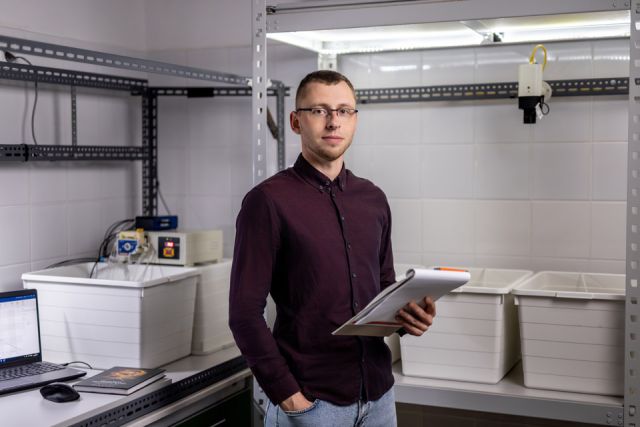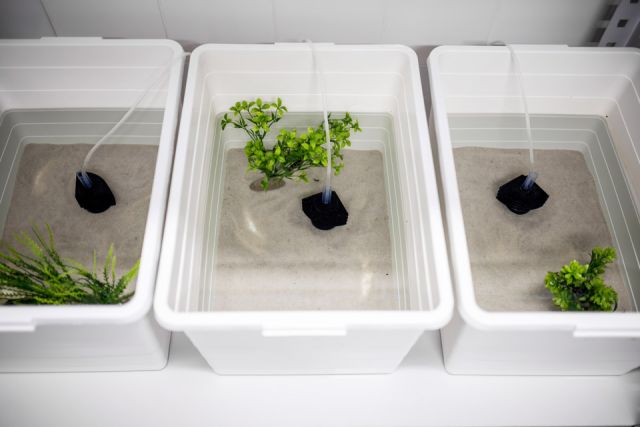Principal Investigator
:
Mateusz Augustyniak
Nicolaus Copernicus University in Toruń
Panel: NZ8
Funding scheme
: PRELUDIUM 22
announced on
23 March 2023
With technological progress, we try to bring more conveniences into our daily lives, including artificial light at night (ALAN). Unfortunately, people are often unaware that ALAN is also a source of environmental pollution that negatively impacts the living organisms around us. Rhythmic internal timing mechanisms, known as biological clocks, regulate many biological processes. These are mainly synchronised by the natural light cycle of night and day, which is disrupted by ALAN.
Currently, more than 50% of the global population live at a distance less than 3 km from rivers, lakes and other freshwater bodies, which means that these ecosystems are as vulnerable to ALAN as terrestrial ones. The increasing number of research focused on ALAN indicate that, in the short-term perspective, it affects many biological processes in a wide range of freshwater organisms, and thus represents a serious threat to global biodiversity. The commonly used white light-emitting diodes (LEDs) could be especially harmful, as they are characterized by a significant peak at wavelengths corresponding to the blue light, to which many living organisms are sensitive.
 Mateusz Augustyniak, photo Łukasz Bera
Another human-mediated biodiversity threat is biological invasions. Biological invasion is a process by which an organism is introduced to a region beyond its natural range, where it becomes established and maintains a stable population, causing negative impacts to native biota through, e.g., predation or competition. There are research pointing out that ALAN modifies the behaviour and distribution of invasive species, as well as their impact on invaded ecosystems. Thus, comprehensive studies that combine the impact of ALAN and the invasive species in freshwater ecosystems are extremely important, because high levels of light pollution are associated with areas with high human interference, which are usually also the main hotspots for invasive species.
Mateusz Augustyniak, photo Łukasz Bera
Another human-mediated biodiversity threat is biological invasions. Biological invasion is a process by which an organism is introduced to a region beyond its natural range, where it becomes established and maintains a stable population, causing negative impacts to native biota through, e.g., predation or competition. There are research pointing out that ALAN modifies the behaviour and distribution of invasive species, as well as their impact on invaded ecosystems. Thus, comprehensive studies that combine the impact of ALAN and the invasive species in freshwater ecosystems are extremely important, because high levels of light pollution are associated with areas with high human interference, which are usually also the main hotspots for invasive species.
Our project aims to expand our knowledge of how ALAN affects freshwater organisms, both native and invasive. We are going to perform a series of laboratory experiments, focused on the long-term impact of light pollution on selected species of freshwater fish with different circadian rhythms. The species characterized by the diurnal lifestyle will be the native Eurasian perch and the invasive pumpkinseed, and for the nocturnal species we select the native European bullhead and the invasive racer goby. Due to ALAN, diurnal species may suffer a disturbed resting phase, which is important for their regeneration and coincides with the dark phase of the day. On the other hand, nocturnal species may become more visible to potential predators during the peak of their activity, which could negatively affect meeting their basic needs, such as feeding.
The fish will be divided into two groups: one kept in the undisturbed light cycle (the control group) and the other in a light cycle disturbed by ALAN provided by the white LEDs (the test group). Our goal is to study their long-term growth and the reactive oxygen species level, because the disruption of the resting phase may adversely affect the mechanisms of eliminating these harmful compounds from the organism. Further, we are going to carry out a series of short-term experiments to better explain potential mechanisms responsible for the findings of the long-term study. These will include a respirometry assay to assess the physical capacity of the fish, as well as their activity and foraging efficiency evaluation.
Comparing the results between the test and the control group will allow us to estimate potential long-term changes in the organism induced by the presence of ALAN. Further, comparing the susceptibility to ALAN of native and invasive species with the same circadian activity could reveal how the latter respond to light pollution, which is essential for understanding their impact on invaded ecosystems, especially in light of the predicted further increase in light pollution worldwide.
Project title: Long-term effects of light pollution on freshwater predators. Does increased light level at night favour invasive over native fish species?
Mateusz Augustyniak
A PhD candidate at the Doctoral School of Exact and Natural Sciences, Academia Scientiarum Thoruniensis, at the Nicolaus Copernicus University in Toruń. His main research interest is the ecology of freshwater organisms, with a special emphasis on invasive species. The main purpose of his research is to investigate the possible traits that give invasive species an advantage over native species, determining their success in the invaded areas. His PhD dissertation involves a comparison of the behaviour between invasive and native freshwater fish species facing stressful situations.


